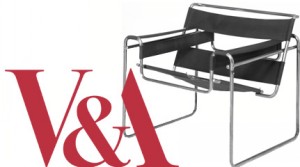
First of all I should admit that Modernism does not really speak to me at all (check out the Modernism microsite – pretty ambitious, though slow to load. And quite a cool ‘Design Your Own Poster’ feature). I have long been of the opinion that people are either Cavaliers or Roundhead (or Romantic or Classical in the parlance of Zen, and the Art of Motorcycle Maintenance) and I am most definitely a Cavalier (with perhaps a sensible Puritan streak on a good day).
I found even being in the exhibition itself – surrounded by lots of black and splashes of red, by towering black display shelves and films of machines – faintly depressing. Something to do with all the straight lines, the lack of colour, the worship of machinery and ‘the workers’. A few curves here and there would have been nice, or what about some lovely non-primary colours – lilac anyone? Or perhaps a touch of aqua?
But I felt I ought to go because it is so fundamental to one’s understanding of 20th century design.
The V&A’s approach is to root the movement squarely in the political and social changes of the first half of the century – the rise of mass production, the importance of hygiene and fitness after the post-war flu epidemic, the rise of the workers after the revolutions in Russia and Germany, new inventions such as film and new materials such as steel, concrete and plastic – which I did find really interesting.
I thought the exhibits themselves were rather lacking in ‘wow’ factor- unlike the recent Art Nouveau and Art Deco exhibitions – endless posters and chairs, an interesting if rather homely reconstruction of the first ever fitted kitchen, a few architectural models by Le Corbusier and a large, and rather gratuitous, silver car. I was struck by how contemporary some of those original chairs and buildings still seem – the Le Corbusier houses would not seem out of place on Grand Designs even now. I know these things were totally revolutionary at the time, but have we really moved on so little in eighty or so years?
It was also interesting to note how ideas which worked well at the level of the private individual, such as the Le Corbusier houses and fitted kitchens, turned into nasty brutalist monstrosities when turned into public architecture or housing on a grand scale. As with the philosophies the inspired the movement, the emphasis on equality and egalitarianism meant that people’s individual needs were ignored and we are still living with the consequences today in our public housing.
It also got me thinking (always a good sign in an exhibition) about whether we are currently in the middle of the next big movement after Modernism. Is today’s current obsession with pattern, colour, asymmetry, gratuitous decoration, free-flowing forms, handmade or craftmade items, and naturalistic motifs such as florals, birds and butterflies merely a temporary blip or are we in the middle of the next big thing? Because the thing that struck me most of all was how quaint and somehow old-fashioned some of this radical design is starting to look.
(Am amazed that I have managed to wax so lyrical in this post. Amazed because I seemed to spend most of the time running after the Minx, who thought she was in heaven – climbing on the benches, attacking the exhibits, running up and down a nice long ventilator grill, tap dancing on a noisy square of shiny metal flooring. She also hooked up with a handsome fourteen-month old by the name of Jack and spent a lot of time giving him very overwhelming cuddles, dribbly kisses or else trying to poke his eyes out. Thereby proving conclusively that exhibitions are indeed excellent places to pick up eligible young men.)

Leave a Reply